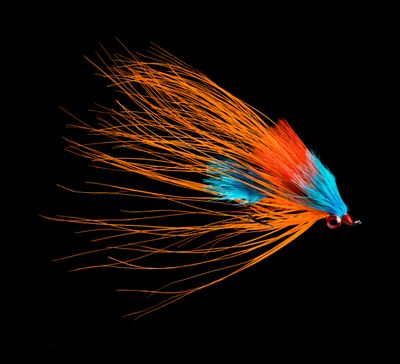Photographer casts light on master fly tier’s devotion to detail

The most important parts of a fishing fly is its presentation in the water – deep or on the top, the quality of the cast.
Second most important, said master fly tier John Newbury, is the lure’s silhouette as it appears to the fish.
Aesthetics come in only third, said Newbury, whose work – magnified from insect size to 2-foot-wide images by Spokane photographer Tony Roslund – are hanging at Steelhead Bar & Grille downtown as part of the twice-yearly Visual Arts Tour. Against the restaurant’s brick walls, Newbury admitted: “They pop.”
And then some, in the eyes of others.
“We see what he does as something more than fly-tying,” said CK Anderson, principal and creative director at helveticka, a Spokane creative firm formerly known as Anderson Mraz. “We see it as an art form.”
Tapped by Johnston Printing to create a publication to showcase its printing capabilities, Anderson’s firm created a magazine, Proof!, that focused on regional artists. Johnston closed after 65 years – Newbury was the subject of the publication’s final issue.
To photograph the flies’ bursts of vivid fluff, the skinny contoured legs, each barb of feather and twist of thread, Roslund strung filament wire – finer than human hair – across his dark studio. Fly in hand, he fished around half-blindly until slender hook snagged invisible line. He aimed studio lights at each fly to illuminate their texture and detail.
Over days, he repeated the process dozens of times to create a 64-fly spread in the magazine that reflects a devotion to minute detail. The images do pop, sometimes alien-looking combinations of fur, hooks, synthetic materials and brilliant feathers that Newbury dyes himself.
In the studio, Roslund said, he received artistic direction from the fisherman: “ ‘This one you want to steam first,’ ” the fisherman told him. “ ‘This one you want to comb down.’ ‘You want to lick this one a little bit to make it slick.’ ”
Newbury, of Chewelah, was in 2007 named the first inductee into the Washington State Fly Tying Hall of Fame. He later received national and international fly-tying honors from the Federation of Fly Fishers. Criteria for the Hall of Fame included creativity and innovation along with a record of sharing fly-tying knowledge with others.
Newbury, 57, has a form of Parkinson’s disease that makes his speech difficult to understand.
Diagnosed in the 1980s, the disease cost him his job as a math teacher and left him bed-ridden for more than a year. It affects his hands, too, he said, which is why he no longer hunts. But he still fishes, and he still performs the delicate work of tying flies.
“It’s a form of relaxation,” he said. “That’s why I don’t do it commercially. If you do it commercially, you have to perform to people’s expectations.”
He gladly teaches others to tie, though, at events like the Visual Arts Tour and fundraisers or to fellow fishers.
“I’m a fisherman first,” Newbury said. “The purpose is to hook the fish.”